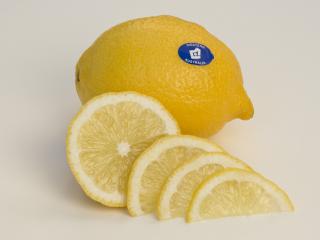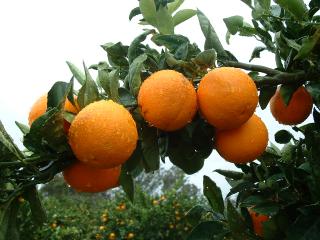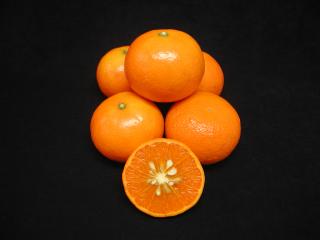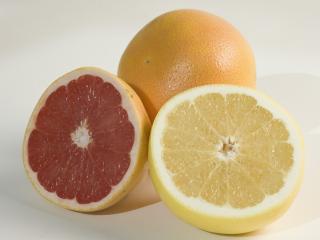The poor, sandy soils of the Perth coastal plain often lead to disappointment for the gardener. Improving soil conditions and ensuring trees get the correct amount of water, trace element sprays and fertiliser will lead to greater success. Citrus do not like frost and special care needs to be taken in frost prone areas.
Varieties
Lemons, mandarins, oranges, grapefruit, tangelos, limes and cumquats can all be successfully grown in south west Western Australia as long as the correct variety is selected.
Lemon
Lemon varieties commonly grown are Eureka, Lisbon and Meyer. Eureka is heavy-bearing, fruits over a long period and has fewer thorns than other varieties. Libson also yields heavily but has the disadvantage of being thorny and only crops in winter and spring. The Meyer lemon has a mild, less acidic flavour and smoother skin but does not bear summer crops.
Orange
There are a large range of navel orange varieties which have fruit harvested from late May through to November. Early varieties include Navelina and Newhall, mid season varieties include Washington, Cara Cara (red fleshed variety) and Atwood. Late varieties include Late Lane, Chislett and Powell. All navel varieties are seedless but their shape can vary from oval to round. Valencia oranges will also grow well and will produce sweet fruit through the summer period. Seedless varieties of Valencia orange such as Midknight and Delta are also available.
Mandarin
Mandarin varieties worth trying include Imperial, Daisy, Hickson, Afourer, Mystique and Murcott. Imperial and Daisy bear from May to July, Hicksons from July to August, Afourer from August to September and Mystique and Murcott from September to October. Imperial, Hickson and Afourer are easy to peel while Mystique is a mandarin orange cross which is large and juicy with a tighter skin. Thin skinned mandarin varieties are particularly susceptible to Mediterranean fruit fly and control of this pest is essential for a successful crop.
Grapefruit
Grapefruit varieties include Marsh (white fleshed), Rio Red and Star Ruby (red fleshed). The red fleshed varieties will be sweeter and have better colour in warmer areas such as Kununurra and Carnarvon. In Perth fruit needs to hang on the tree until at least September/October to develop a good flavour.
Tangelos
Tangelos are mandarin-grapefruit crosses which produce attractive trees that give good crops of flavoursome fruit from July to October. Good varieties are Minneola and Orlando.
Lime
The best variety of lime to grow in the Perth region is the Persian or Tahitian lime. This lime is seedless and far more cold tolerant than the West Indian lime. There are also a range of native limes and native lime hybrids available. Some varieties are thorny and their small fruits vary in colour and shape.
Cumquat
A number of different cumquats are available including Nagami and Marumi. These are small, round or oval in shape, and usually orange in colour. They are prolific bearers that make excellent marmalade and preserves.
Multi graft and dwarf
Multi grafted trees with more than one variety or citrus type on the same tree are sometimes available. These trees have the advantage of providing a range of fruits from a single tree but need careful pruning and training to prevent one variety or citrus type from “taking over” from the others.
Most citrus are available on 'Flying Dragon' dwarfing rootstock which creates trees that grow to about half the size of conventional citrus trees with full sized fruit.
Buying trees
Only buy trees from a reputable source. Look for trees with healthy green growth, no leaf yellowing or leaf drop and that look proportional to the pot they are growing in. Trees that have been in the nursery for a long time can be pot bound which means that root strangling and entwining may have occurred.
A common fallacy is that older bigger trees will grow and fruit better than smaller trees. One-year-old trees can be more successful than older trees that may be pot bound and will need more pruning after planting.
Planting
Much of the success with citrus trees depends on the initial start the young trees receive.
Select a site that doesn’t compete with established trees or lawns, is protected from strong winds and has a sunny aspect. It is preferable to plant trees in spring after the risk of frost has passed. However, trees can be planted from autumn to spring in warmer areas.
Dig a hole 75cm deep by 75cm wide, and apply a mixture of compost, phosphorous (rock phosphate at 1kg per tree, or superphosphate at 500g per tree) and trace elements (100g per tree). Mix this up with some soil in the bottom of the hole and place some soil without fertiliser over the top. In sandy soils add about 5% clay to the improved soil to help with water retention. Plant the young tree on top making sure the roots don’t touch any fertiliser grains and that the bud union (variety and rootstock join) is well above the ground level. If the bud union is covered with soil this can allow diseases such as collar rot to develop in the tree.
Try not to disturb the root ball too much at planting. Firm the soil around the roots, apply a wetting agent and water immediately.
It is advisable to prune the top of larger trees after planting. If the top has many branches cutting back to three well-balanced branches 15 to 20cm long will develop a healthy framework. If the top of the tree is too big for the root ball to support leaf drop and poor development will occur in the year after planting.
Caring for young trees
The trunk of the young tree should be protected from the sun in the first few months after planting. This can be done using commercially available tree guards or by loosely wrapping the trunk with shade cloth or a similar material.
Spread mulch around the tree to cool the soil in summer and reduce moisture loss. Apply sufficient water to keep the soil moist to a depth of 30 to 50cm. During the first growing season apply a commercial, slow release fertiliser, following label instructions for application rates. Frequent applications of small amounts of fertiliser will stimulate growth and bring the tree into bearing sooner. Liquid fertilisers containing trace elements, compost and fish can be applied to the foliage of the trees monthly to boost growth and address trace element deficiencies.
Established trees
A common mistake is to prepare the soil carefully before planting, but fail to adequately supplement the tree in later years. This reduces growth and bearing.
Citrus trees need a lot of nitrogen and potassium, and small amounts of phosphorous and trace elements. In Perth’s sandy soils a suitable fertiliser programme providing all the trees nutrient requirements is essential. Apply 50g of a suitable balanced fertiliser containing nitrogen, phosphorous and potassium to each tree every five weeks in spring (3 to 4 applications). Also apply a commercial citrus fertiliser mix containing trace elements (as recommended on the label) during the growing season. One or two additional trace element sprays in spring and during fruit set will improve fruit quality. Always water trees before applying fertiliser and do not use excessive fertiliser as too much can burn the leaves and cause leaf drop.
Using organic matter like compost or well rotted manure beneath the mulch encourages beneficial organisms and reduces summer soil temperatures.
Remove weeds by hand being careful not disturb the soil around the trees more than necessary. If spraying weeds avoid foliage contact with herbicides such as glyphosate as these can cause severe damage, particularly in young trees.
Watering should aim to wet all the roots of the tree. Citrus are shallow rooted with the main mass of roots located in the top 30 to 40cm of the soil under the tree canopy. As the spread of water is poor in sand the full root perimeter should be watered. Watering from a hose running under the tree soaks quickly into the ground without benefiting the main lateral roots and also washes soluble nutrients away from the roots.
Citrus trees do not need extensive pruning, but shoots developing on the trunk should be removed and the trees should not be allowed to get too big to make it easier to pick fruit and control fruit fly. On older trees, strong shoots from the main head should be shortened or removed to prevent the tree becoming unbalanced.
Old trees will benefit from periodical pruning, involving thinning out limbs where they have become thick and entwined and removing dead wood.
Pests and diseases
Mediterranean fruit fly is the most destructive pest. Mandarin varieties are particularly susceptible and growers must control this pest to achieve success. Lemons and grapefruit are less susceptible to fruit fly damage but can also be stung. Baiting and netting are the only way to combat this pest. Other pests are scales, aphids, crusader bugs, leaf miner, snails and whitefly.
Consult the Department of Agriculture and Food web article 'Citrus pests' for further information. Fungus diseases attacking citrus trees are collar rot (phytophthora) which girdles the trunk, and Armillaria root rot, which attacks and kills the roots of trees. Fruit rots caused by blue and green moulds are also often seen on fruit hanging in the tree canopy, particularly those that have rind damage caused by wind or insects.
Other disorders
Unfavourable weather causes considerable damage to citrus fruits. Excessive heat will cause heavy shedding of young fruits, and strong sun light conditions can lead to sunburn causing internal decline. When cut open, sunburnt fruit will be normal on one side but have brown pulp and dry flesh on the burnt side.
Fruit drop may be minimised with good management, such as adequate watering and mulching.






